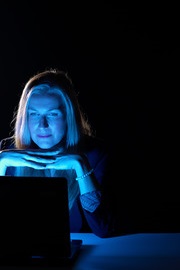Do Blue Light Glasses Work? A Scientific Look at Their Possible Benefits
Technology is continually becoming a bigger and bigger part of our everyday world. This has been an ongoing trend for quite some time now, but was specifically accelerated over the past few years. The major technological and digital acceleration that happened recently was largely due to the impact of the COVID-19 pandemic spreading across the globe.
As the pandemic reached its peak, businesses were shutting down left and right unless they were able to successfully transition to remote and digital operations. As a result, students began taking classes online and the remote-work and work-from-home cultures have absolutely erupted.
Additionally, though, this means that more students and professionals than ever before are performing the majority of their work tasks through a screen of one type or another. A laptop or desktop computer, a tablet, a video-conference, or any other tech-facilitated activity today likely involves a screen.
Additionally, even our freetime is overloaded with technology and the presence of screens. From social media, to mobile gaming, to console-gaming, television streaming, and just about everything in between. Almost everything we do in a day in 2022 involves a screen.
While technology can certainly make life a lot easier, spending all of our waking moments in front of screens simply isn’t good for the health of our eyes in the long run. This is why blue-light glasses have come about and risen in popularity over the past few years.
What is Blue Light?
Blue light is a wavelength that’s naturally present in a light source. In fact, blue light is even present in light that’s emitted from the sun. However, blue light is a particularly short wavelength which many doctors associate with a higher risk for eye-damage. Because blue-light is a naturally present wavelength in all light, it is actually emitted from the majority of electronics. Even lightbulbs and other less intricate forms of technology radiate a percentage of blue light.
TV screens, computer monitors, and other high-end-technology though, are often created with LCDs or liquid crystal displays. As such, LCD screens produce a lot more blue light than non LCD screens. However, because of the clarity and crisp imaging that LCD screens provide, they continue to be a popular choice for consumers and manufacturers alike.
It’s also important to note that most of the harm from blue-light comes from over-exposure, and that blue-light isn’t innately bad for us. In fact, blue-light can also improve alertness, awareness, and be a signal to our bodies and brains that it’s time to get up and start the day.
Understanding all of the different ways that blue light is naturally present in our lives, as well as all of the additional sources of blue-light that we utilize in our normal everyday routines can illuminate a need for greater eye-protection if possible. Afterall, we rely on our eyes in more ways than we even realize.
The Potential Harm of Over Exposure to Blue Light
Over exposure to blue light has been associated with headaches, eye strain, visual fatigue, and has even been identified as a culprit in interrupting one’s natural circadian rhythm. Chronic headaches can be a nightmare to deal with, while having an abnormal circadian rhythm can make it difficult to ever get a reliable amount of sleep in a night.
Not only that, but if you’re someone who needs to be able to read large spreadsheets or deals with data on a regular basis, visual fatigue and eye strain can really tamper your ability and in turn, productivity.
The Theory Behind Blue Light Lenses
The idea behind blue light blocking glasses is that they’re made with a specially designed lens that blocks or drastically reduces the amount of blue light able to pass through. In turn, this cuts down on computer-screen-induced eye-strain, visual fatigue, and can even help lessen the severity of screen-induced headaches.
As such, if blue light blocking glasses can be successfully manufactured, working professionals, pro-gamers, and anyone else who finds themselves regularly using a screen for hours-on-end, can finally rely on a product that will reduce eye strain and fatigue caused by the short blue-light wavelength.
What the Science Says so Far
However, this is kind of a big if. The studies conducted on blue light blocking glasses have been relatively inconsistent and inconclusive so far. There have been multiple trials conducted with blue-light blocking glasses, but the results haven’t proven anything definitively.
While more research and trials are needed on the efficacy of blue-light blocking glasses, some individuals still swear by them, and they may be worth trying for yourself.
Final Thoughts on Blue Light Lenses
If you’re regularly using screens for hours at a time in your day-to-day life, you may be looking for ways to reduce eye strain and vision fatigue. The best way to reduce these effects is by taking regular 10 minute breaks every hour or so. If you’re looking for more, though, blue light blocking lenses may just work for you.




